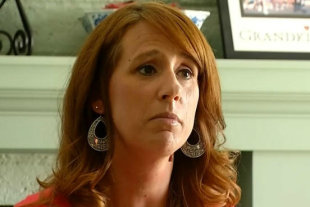Stand-up day makes Tex. senator a star
Wendy Davis strode onto the floor of the Texas Senate chamber
on Tuesday in rouge-red running shoes, and came off it early Wednesday morning
as the Democratic Party’s newest star.
 ERIC GAY/ASSOCIATED PRESS Texas state Sen. Wendy Davis (D-Fort Worth) stood on the
near-empty floor of the Texas Senate on Tuesday afternoon as she filibustered a
bill that would ban abortions in the state after 20 weeks of pregnancy. Below,
Davis and fellow Democratic senator Jose Rodriguez of El Paso celebrate after
time ran out on the bill.
ERIC GAY/ASSOCIATED PRESS Texas state Sen. Wendy Davis (D-Fort Worth) stood on the
near-empty floor of the Texas Senate on Tuesday afternoon as she filibustered a
bill that would ban abortions in the state after 20 weeks of pregnancy. Below,
Davis and fellow Democratic senator Jose Rodriguez of El Paso celebrate after
time ran out on the bill.
During 13 hours in between, the little-known legislator from Fort Worth
delivered a filibuster that electrified social media and stopped passage of one
of the nation’s toughest set of abortion restrictions in the waning hours of a
special session. As word spread, supporters thronged the capitol’s entrances, lined the
walkways encircling the rotunda and turned the Senate chamber’s gallery into a
cheering section.
What made the scene so riveting was the woman who was required to speak without a break, without straying from the topic and without even leaning on her antique walnut desk. As time ran out, Republicans deemed her to have violated those rules — including once for being helped with a back brace — and made her give up the floor.
Such was the bedlam, however, that when the 19-10 vote finally happened, it came several minutes too late for a midnight deadline.
That kind of tenacity has also been the story of her life. Davis, 50, became a mother while still in her teens, lived for a time in a trailer park and graduated with honors from Harvard Law School.
As she spoke, Twitter registered 400,000 tweets with the hashtag #standwithwendy. One of them came from the official account of President Obama, and said: “Something special is happening in Austin tonight.”
But it was a rare — and likely temporary — victory for abortion rights advocates.
Davis succeeded in running out the clock on the session. So late Wednesday afternoon, Texas Gov. Rick Perry (R) announced that he would call the legislature back for another special session, to begin July 1. The abortion bill appears certain to be considered again, and if the Republican leadership acts quickly enough, it will not be subject to a filibuster.
“Obviously, if he brings that back again and the management in the capitol on both sides manages time better than they did when we started this past special session, that bill will pass,” Davis conceded in an interview.
The legislation would ban abortions after 20 weeks of pregnancy, which is about four weeks before a fetus is viable; mandate abortion clinics to meet the same standards as hospital-style surgical centers; and require doctors who perform the procedure to have admitting privileges at nearby hospitals.
Advocates of the legislation say it is a means of assuring abortion is safe; opponents say it would force nearly every abortion clinic in the state to close.
In the 2012 presidential and Senate elections, Republicans felt a backlash for waging what Democrats branded a “war on women,” particularly on questions involving contraception and abortion.
What made the scene so riveting was the woman who was required to speak without a break, without straying from the topic and without even leaning on her antique walnut desk. As time ran out, Republicans deemed her to have violated those rules — including once for being helped with a back brace — and made her give up the floor.
Such was the bedlam, however, that when the 19-10 vote finally happened, it came several minutes too late for a midnight deadline.
That kind of tenacity has also been the story of her life. Davis, 50, became a mother while still in her teens, lived for a time in a trailer park and graduated with honors from Harvard Law School.
As she spoke, Twitter registered 400,000 tweets with the hashtag #standwithwendy. One of them came from the official account of President Obama, and said: “Something special is happening in Austin tonight.”
But it was a rare — and likely temporary — victory for abortion rights advocates.
Davis succeeded in running out the clock on the session. So late Wednesday afternoon, Texas Gov. Rick Perry (R) announced that he would call the legislature back for another special session, to begin July 1. The abortion bill appears certain to be considered again, and if the Republican leadership acts quickly enough, it will not be subject to a filibuster.
“Obviously, if he brings that back again and the management in the capitol on both sides manages time better than they did when we started this past special session, that bill will pass,” Davis conceded in an interview.
The legislation would ban abortions after 20 weeks of pregnancy, which is about four weeks before a fetus is viable; mandate abortion clinics to meet the same standards as hospital-style surgical centers; and require doctors who perform the procedure to have admitting privileges at nearby hospitals.
Advocates of the legislation say it is a means of assuring abortion is safe; opponents say it would force nearly every abortion clinic in the state to close.
In the 2012 presidential and Senate elections, Republicans felt a backlash for waging what Democrats branded a “war on women,” particularly on questions involving contraception and abortion.
But there is a political tide pulling in the other direction. During the more
than two years since the 2010 elections strengthened Republican power in state
capitals across the country, many have moved to put new limitations on abortion.
Last year alone saw 19 states enact 43 new provisions aimed at restricting abortion, according to the Guttmacher Institute, an advocacy and research organization that promotes abortion rights but produces data that are often cited by advocates on both sides of the issue.
Kathy Hawken, a Republican state legislator who had been among the leaders of the unsuccessful fight against North Dakota’s restrictive new abortion law, was on a vacation getaway with girlfriends when news of Davis’s filibuster came across her Facebook feed.
“I was impressed, particularly in Texas,” she said. “I’m hopeful that this is the start of something bigger.”
The abortion debate has revived in Washington as well following the conviction last month of Philadelphia physician Kermit Gosnell, who was found guilty of three acts of first-degree murder in the deaths of infants born alive while he was performing late-term abortions.
Last week, the Republican-led U.S. House passed a bill that would ban almost all abortions after 20 weeks’ gestation. While the bill stands no chance in the Senate and is constitutionally questionable, its supporters say it will be an isssue that energizes conservative voters in the 2014 elections.
“Just talking about the economy all the time, jobs and the economy, doesn’t motivate people to get out and vote,” said Marilyn Musgrave (R), a former congresswoman from Colorado who now serves as a vice president of the Susan B. Anthony List, an organization that recruits antiabortion women candidates to run for office.
Davis’s own political future has also become a hot topic.
As a newcomer to a legislature that meets in regular session for only 140 days every other year, the former city councilwoman was named “rookie of the year” by Texas Monthly magazine in 2009, and made the magazine’s list of 10 best lawmakers this year.
Davis had already established a reputation for stepping up in a fight. The filibuster on the antiabortion legislation was actually her second of note; in 2011, she did the same in the closing hours of the legislative term in an attempt to stop a budget bill that included education cuts. Perry was forced to call a special session to get them through.
So it is no surprise that she has become one of the GOP’s top electoral targets. Next year, she is up for reelection in a district where she has eked out two narrow wins. The question now is whether she takes advantage of her newfound stardom to make a bid for statewide office — something no Texas Democrat has won since 1994.

 “Last night, she clearly became a person of heroic proportions
to a lot of Democrats, to a lot of women and a lot of young people,” University
of Texas political scientist and pollster James Henson said Wednesday. “In the
long to medium run, another reality will set in — this is still a very
Republican state.”
“Last night, she clearly became a person of heroic proportions
to a lot of Democrats, to a lot of women and a lot of young people,” University
of Texas political scientist and pollster James Henson said Wednesday. “In the
long to medium run, another reality will set in — this is still a very
Republican state.”
Last year alone saw 19 states enact 43 new provisions aimed at restricting abortion, according to the Guttmacher Institute, an advocacy and research organization that promotes abortion rights but produces data that are often cited by advocates on both sides of the issue.
Kathy Hawken, a Republican state legislator who had been among the leaders of the unsuccessful fight against North Dakota’s restrictive new abortion law, was on a vacation getaway with girlfriends when news of Davis’s filibuster came across her Facebook feed.
“I was impressed, particularly in Texas,” she said. “I’m hopeful that this is the start of something bigger.”
The abortion debate has revived in Washington as well following the conviction last month of Philadelphia physician Kermit Gosnell, who was found guilty of three acts of first-degree murder in the deaths of infants born alive while he was performing late-term abortions.
Last week, the Republican-led U.S. House passed a bill that would ban almost all abortions after 20 weeks’ gestation. While the bill stands no chance in the Senate and is constitutionally questionable, its supporters say it will be an isssue that energizes conservative voters in the 2014 elections.
“Just talking about the economy all the time, jobs and the economy, doesn’t motivate people to get out and vote,” said Marilyn Musgrave (R), a former congresswoman from Colorado who now serves as a vice president of the Susan B. Anthony List, an organization that recruits antiabortion women candidates to run for office.
Davis’s own political future has also become a hot topic.
As a newcomer to a legislature that meets in regular session for only 140 days every other year, the former city councilwoman was named “rookie of the year” by Texas Monthly magazine in 2009, and made the magazine’s list of 10 best lawmakers this year.
Davis had already established a reputation for stepping up in a fight. The filibuster on the antiabortion legislation was actually her second of note; in 2011, she did the same in the closing hours of the legislative term in an attempt to stop a budget bill that included education cuts. Perry was forced to call a special session to get them through.
So it is no surprise that she has become one of the GOP’s top electoral targets. Next year, she is up for reelection in a district where she has eked out two narrow wins. The question now is whether she takes advantage of her newfound stardom to make a bid for statewide office — something no Texas Democrat has won since 1994.
Printed and distributed by NewpaperDirect |
www.newspaperdirect.com | Copyright and protected by applicable law.








